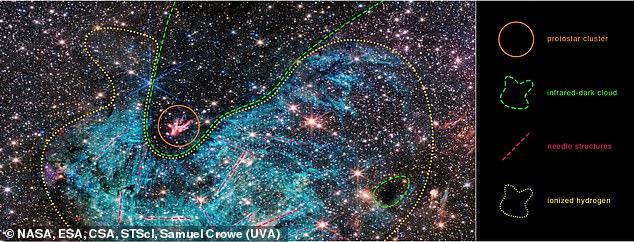- The image could help scientists learn about star formation in the galactic center
- The telescope can analyze each of the 50,000 stars individually
- READ MORE: James Webb captures image of the second-most distant galaxy
NASA‘s James Webb Space Telescope (JWST) has revealed the heart of our Milky Way in never-before-seen ‘unprecedented detail.’
The stunning image shows over 50,000 stars and chaotic clouds at the galactic center, about 300 light-years from a supermassive black hole and 25,000 light-years from Earth.
While astronomers have long known about the features, the new image could finally answer the mysteries of this extreme environment.
One, in particular, is how the star-forming region called Sagittarius C can still birth a new massive self-luminous celestial body while being blasted with radiation from the sun.

The stunning image shows over 50,000 stars and chaotic clouds at the galactic center, about 300 light-years from a supermassive black hole and 25,000 light-years from Earth
The observation team’s principal investigator, Samuel Crowe, who is an undergraduate student at the University of Virginia in Charlottesville, said: ‘There’s never been any infrared data on this region with the level of resolution and sensitivity we get with Webb, so we are seeing lots of features here for the first time.
‘Webb reveals an incredible amount of detail, allowing us to study star formation in this sort of environment in a way that wasn’t possible previously.’
The amazing image was made possible using JWST’s infrared camera, NIRCam (Near-Infrared Camera).
This instrument detects light from the earliest stars and galaxies in the formation process, the population of stars in nearby galaxies, and young stars in the Milky Way and Kuiper Belt objects.
Nestled within some 50,000 stars is a cluster of protostars – stars still forming and gaining mass – releasing streams that scientists said glow like a bonfire against the dark cloud.

The amazing image was made possible using JWST’s infrared camera, NIRCam (Near-Infrared Camera)
The team discovered a previously unknown protostar that has a mass 30 times that of our sun.
‘The cloud the protostars are emerging from is so dense that the light from stars behind it cannot reach Webb, making it appear less crowded when, in fact, it is one of the most densely packed areas of the image, the team shared in a statement.
‘Smaller infrared-dark clouds dot the image, looking like holes in the starfield. That’s where future stars are forming.’
JWST’s NIRCam also captured emissions outside the illuminated star-forming region, which Crowe said are being released by young massive stars.
Rubén Fedriani, a co-investigator of the project at the Instituto Astrofísica de Andalucía in Spain, said: ‘The galactic center is a crowded, tumultuous place. There are turbulent, magnetized gas clouds that are forming stars, which then impact the surrounding gas with their outflowing winds, jets, and radiation.
‘Webb has provided us with a ton of data on this extreme environment, and we are just starting to dig into it.’
The team also said that JWST is powerful enough to investigate individual stars at the galactic center, allowing scientists to learn how they form and how the environment impacts such formation.
The image could answer questions like are more massive stars formed in the center of the Milky Way, as opposed to the edges of its spiral arms?
‘The image from Webb is stunning, and the science we will get from it is even better,’ Crowe said.
‘Massive stars are factories that produce heavy elements in their nuclear cores, so understanding them better is like learning the origin story of much of the universe.’












